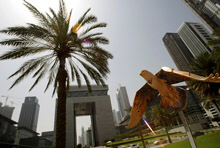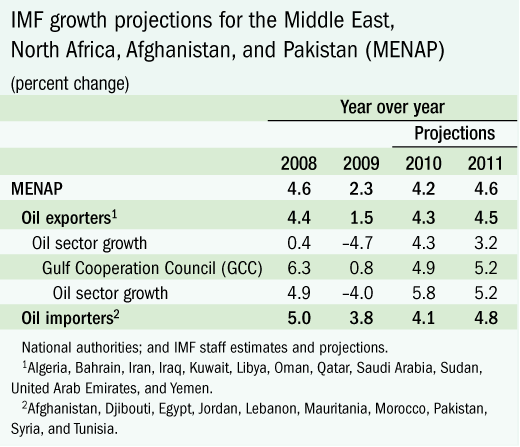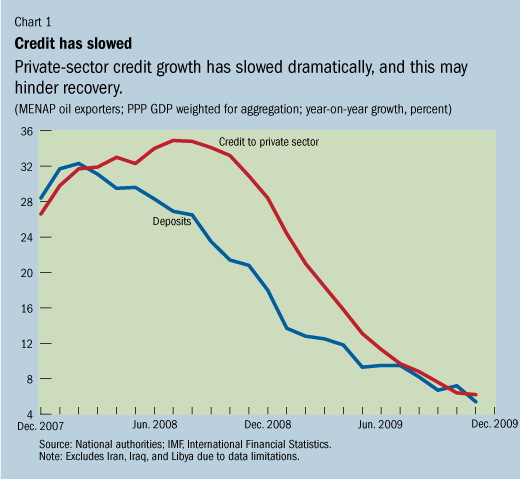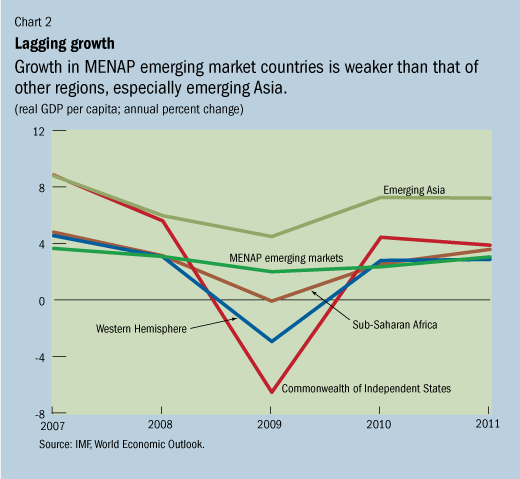
Typical street scene in Santa Ana, El Salvador. (Photo: iStock)
IMF Survey: Growth Picks Up in Middle East, But Credit Still Sluggish
May 25, 2010
- Strong oil demand underpins a promising medium-term outlook
- Banking system stress, low credit growth could dampen prospects
- Improving competitiveness, raising growth are key for region’s emerging markets
Growth in the Middle East, North Africa, and Pakistan (MENAP) is set to reach 4.2 percent in 2010 as the global economy recovers, but the region is still coping with the legacy of the global economic crisis, the IMF says in its new regional forecast.

Outside the Dubai International Financial Centre: the region is still coping with the legacy of the global economic crisis, IMF says (photo: AFP/Karim Sahib)
REGIONAL ECONOMIC OUTLOOK
IMF Middle East and Central Asia Department Director Masood Ahmed told a May 25 press conference in Dubai that the outlook for the region had improved considerably from 2009.
“We expect growth to gather momentum in 2010, helped by the pickup in capital inflows and the resurgence in domestic consumption,” Ahmed told reporters. “However, this positive perspective is clouded by some stress in the banking system and lethargic credit activity across the region.”

Oil exporters emerge from crisis
The region’s oil exporters—Algeria, Bahrain, Iran, Iraq, Kuwait, Libya, Oman, Qatar, Saudi Arabia, Sudan, the United Arab Emirates, and Yemen—were hit hard in 2009. Crude oil prices fell to $40 a barrel, real estate and asset prices plunged, and external financing dried up. The combined current account surplus of these countries fell to $53 billion in 2009, after having risen more than tenfold in the previous decade to $362 billion. Oil GDP for these countries contracted by 4.7 percent.
The authorities reacted swiftly to the crisis, however, and a massive increase in government spending—along with central bank liquidity support and capital injections into the banking sector—helped mitigate its impact. As a result, non-oil economic activity continued to expand in these economies, by some 3.6 percent in 2009.
MENAP oil exporters are now emerging from the crisis, thanks to a resumption of capital inflows and a rebound in crude oil prices to over $80 a barrel, the report noted. Higher oil prices and output are projected to boost the current account surplus to $140 billion and oil-GDP growth to 4.3 percent. Non-oil sector activity, supported by sustained fiscal stimulus in some countries, is also forecast to grow by 4.1 percent.
The region’s oil exporters still face challenges in their banking systems, however, where credit to the private sector remains sluggish and losses on nonperforming loans have yet to be fully recognized, Ahmed said. Following an extended period of high growth through mid-2008, credit in these countries slowed by an average of almost 30 percentage points by end-2009 (Chart 1). Governments will have to balance the goal of reactivating credit with the need to strengthen financial regulations and enhance supervision, particularly in countries where there is evidence that excessive risk-taking occurred.

Over the medium term, policymakers also face a delicate balancing act in unwinding official support to the financial sector—and in phasing out the fiscal stimulus, which is projected to last through 2010 but should be discontinued once a solid recovery is achieved.
Emerging markets’ growth picks up—but slowly
The region’s emerging markets—Afghanistan, Djibouti, Egypt, Jordan, Lebanon, Mauritania, Morocco, Pakistan, Syria, and Tunisia—are recovering from last year’s slowdown, but growth remains below the levels needed to reduce high unemployment and falls short of that in other emerging markets (Chart 2). These countries’ limited financial and trade ties—combined with positive spillovers from fiscal expansions in the MENAP oil exporters—helped offset the impact of the global slowdown. As a result, overall growth fell only modestly to 3.8 percent in 2009, from 5 percent in 2008.

With trade rebounding since mid-2009 and investment and bank credit beginning to pick up, growth is projected to increase marginally to 4.1 percent in 2010 and 4.8 percent in 2011. These growth rates, however, are insufficient to create the jobs needed for a region with a rapidly expanding workforce and a high rate of unemployment. Credit growth—which fell to a weighted average of 2 percent in the year to October 2009 from almost 20 percent before the crisis—also remains low, as it does elsewhere in the region. At the same time, inflation remains relatively high in many countries, mainly on account of higher food and energy prices.
The report likewise notes that the resurgence of capital inflows witnessed in other emerging markets is not yet evident in most MENAP oil importers. Continued weakness in European demand, appreciated exchange rates, and competition from other emerging markets is hampering the potential for export-led growth.
“The main challenge for emerging markets in the Middle East will be to improve their competitiveness in order to raise growth and generate much-needed employment,” Ahmed said.







